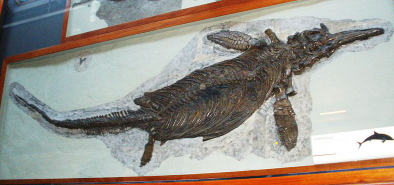Chilean researchers discovered the country's first complete ichthyosaur and over two dozen additional fossils, thanks to a melting glacier in Patagonia.
Intensive Study
Meet "Fiona", Chile's first complete ichthyosaur, a pregnant mother recovered from a glacier in Patagonia!
I'm thrilled to have been part of this incredible expedition led by my good friend and colleague, Dr @judkasan (pictured) from The University of Magallanes (@umagallanes). pic.twitter.com/rclwMEQZxA
- Dr Dean Lomax (@Dean_R_Lomax) May 10, 2022
In March and April, a team of researchers from the University of Magallanes (UMAG) launched an excursion to Chile's Patagonia's Tyndall Glacier in search of the remnants of a four-meter-long prehistoric marine reptile.
The fossil, discovered in 2009 by the same team's leader, Dr. Judith Pardo-Pérez, associate professor at UMAG, was dug up again, pregnant and with a few embryos still nestled amid her remains.
The beast's bones, dubbed Fiona by the crew, were discovered during a 31-day trip in which researchers hiked 10 hours to the isolated dig site alone and stayed in tents.
According to a news announcement announcing the discovery, 23 fresh specimens were discovered at an astonishing rate throughout the voyage. "On the days that the crew was able to go to the site, they recorded the ichthyosaurs and other fossils and found new specimens."
Uncovering Ancient Fossils

According to the press release, Dr. Pardo-Pérez believes the location has the "most plentiful and best preserved" cretaceous ichthyosaur deposit in the world following this year's expedition.
"We hope to obtain results on the diversity, disparity, and paleobiology of the ichthyosaurs of the Tyndall Glacier locality," she said in the press release, adding that more research into the region's diversity will help the team better understand how the ichthyosaurs are related to those found at other latitudes.
"The significant quantity of ichthyosaurs recovered in the region, including entire bones of adults, juveniles, and neonates, gives a unique insight into the past," Lomax said.
Fiona, which was helicoptered out of the glacier for research, was traced back to the Valanginian-Hauterivian era, a part of the Early Cretaceous period (which culminated with the extinction of dinosaurs) that occurred between 129 and 139 million years ago.
Ichthyosaurs are warm-blooded marine reptiles with long rostrums and short, sharp teeth that resemble dolphins or swordfish.
Dr. Pardo-Pérez has made more than 10 journeys to the Tyndall fossil site since 1997, when 55 mph gusts and heavy rain created hurdles in the excavation and preservation process. Fiona was protected from the weather by a hangar. The crew utilized diamond tools to drill and shatter strong blocks of granite that surrounded her body-tougher instruments than the lump hammer, chisel, and brush.
Preparations For Research
Fiona is presently being prepared for research and exhibition at the Ro Seco Natural History Museum in Punta Arenas. Still, Dr. Pardo-Pérez is concerned about the other ichthyosaur fossils that will never be discovered.
"We have about a hundred ichthyosaurs in the Tyndall Glacier fossil deposit. Many of them will never be excavated due to the difficulties of access and the fact that they are in dangerous regions," she added.
"The ichthyosaurs that will not be dug require preservation and consolidation in situ, as the daily erosion to which they are exposed is killing them."
For similar news, don't forget to follow Nature World News!
© 2025 NatureWorldNews.com All rights reserved. Do not reproduce without permission.





